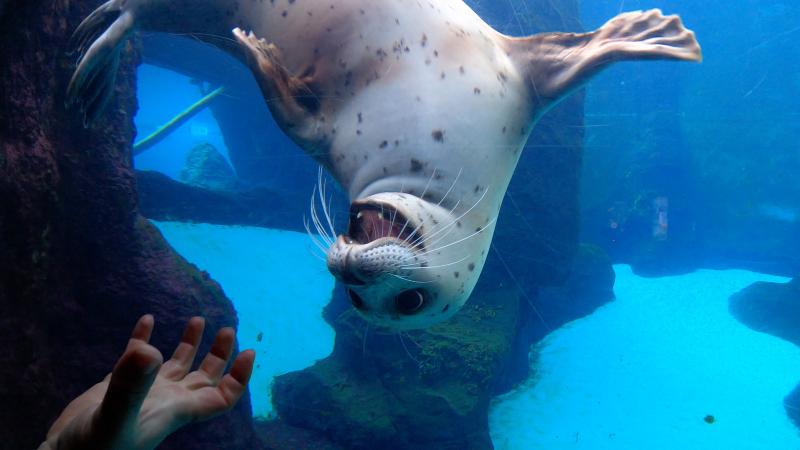New training routine keeps harbor seals in shape

Tongass, Atty and Kaya benefit mentally and physically from shape discrimination
Forget Wordle or spin class. The latest craze in mental and physical fitness is shape training — if you’re a harbor seal at the Oregon Zoo, that is. Care staff in the zoo’s marine life area are working with harbor seals Tongass, Atty and Kaya on recognizing specific shapes both above and below the water, and they’re getting great results.
“Harbor seals are really smart, and we want to keep them active and engaged,” said Nicole Nicassio-Hiskey, a senior keeper who cares for the seals. “Training sessions like these help us build strong relationships with the seals, and it makes our time together that much more fun.”
Each harbor seal is assigned their own shape — Tongass the star, Atty the moon and Kaya the triangle. When Nicassio-Hiskey gives them a cue, they dive below the surface and head toward an underwater viewing window, where other keepers are holding shapes against the glass. Once the seals find their marks, keepers might request a series of behaviors — like “spin,” “flipper present” and “mouth open.” And after they complete their routine, the seals are rewarded with some of their favorite foods.
According to Nicassio-Hiskey, they’re learning quickly and having a good time doing it, but the training also serves a higher purpose.
“Practicing these behaviors in a fun environment helps the harbor seals participate in their own care,” she explained. “If they ever need a dental check or an x-ray, we can provide that without causing a lot of stress.”
And there’s no doubt the seals are enjoying themselves.
“When they see the shapes, they start zooming around really fast, and they get so excited,” Nicassio-Hiskey said. “And guests like to watch shape training too.”
Visitors to the zoo might be able to catch a glimpse of the new routine in action. The training takes place in the underwater viewing area at Steller Cove a few times a week, and the harbor seals are in great shape.
Harbor seals are graceful underwater and can swim forward, backward and upside-down, but they are awkward on land, where they flop along on their bellies. Depending on what they're hunting, they dive 300 to 1,500 feet. During a dive, their nostrils close and their heart rate slows from 100 beats per minute to about 5 beats per minute. These changes allow them to stay underwater as long as 35 minutes.
More News

Rescued cougar cubs are venturing out
A pair of orphaned cougar cubs, rescued and brought to the zoo by Washington Department of Fish and Wildlife staff in November, have begun exploring their outdoor habitat.April 17, 2025

Zoo seeks pika watchers for summer season
The Oregon Zoo is recruiting volunteers for Cascades Pika Watch.April 15, 2025

Zoo convenes action for imperiled elephants
Sabah government representatives joined conservation NGOs, local communities, palm oil producers, and tourism operators this week in the fight to save the world’s smallest elephants from extinction.April 11, 2025

